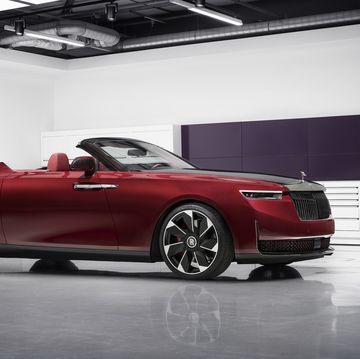Lotus never competed in the original Can-Am championship, but it wanted to. Now, a mere 53 years late, the British sports-car company is set to produce a limited run of the car it started work on for one of the most spectacular race series of all time, but which never got built. The Lotus 66 has just been unveiled Friday at the The Quail during Monterey Car Week. Only 10 of these track-only specials will be built, with each carrying a seven-figure pricetag.
The Canadian-American Challenge Cup, invariably abbreviated to Can-Am, was first run in 1966 and was about as close to ‘anything goes’ racing as top flight motorsport has got. Run under Group 7 Sportscar regulations, Can-Am cars needed to have wheels enclosed by bodywork and meet dimensions. But there was no stipulation for minimum weight and both engine choice and aerodynamics were effectively unrestricted. Although it was a North American series, British outfits Lola and McLaren dominated Can-Am’s early years - in 1969 McLaren won every single round, Bruce McLaren taking six victories and Denny Hulme five.
Lotus’s entrepreneurial boss Colin Chapman was keen to have a slice of this pie and told Team designer Geoff Ferris to come up with a proposal for a car to compete in the series. Work on this started in September 1969, and although the project never advanced enough to get allocated a type number, it is likely it would have become the Lotus Type 66 had it continued. Ferris’s early sketches featured a raised ‘narcell’ - like a Formula 1 cockpit - to smooth airflow around the driver, plus a very long tail. The original proposal was for a stilted wing raised high above the back of the car to sit in clean airflow. But when Lotus learned that Can-Am was set to follow F1’s lead in banning such wings, it was redesigned to have a lower full-width element integrated into the rear bodywork. Power was undecided, but the Lotus would probably have followed the rest of the Can-Am pack with a Chevrolet V-8 engine.
Lotus’s Can-Am project never went further than these early proposals, the team working flat-out to run its other racing programs from Formula 1 to touring cars. But the original sketches were saved and, a few years ago, rediscovered in a box of microfilm by Classic Team Lotus. At which point CTL’s boss, and Colin Chapman’s son, Clive Chapman persuaded Lotus Cars’ head of design, Russell Carr, to turn these into 3D renderings. That project led ultimately to the car you see here.
The original Can-Am proposal is referenced in the white, gold and red colors cheme of the Type 66, these being Lotus’s corporate colors during the early ‘70s thanks to sponsorship from the Gold Leaf tobacco company. But underneath lies a significant amount of modern technology, the most obvious anachronism being the use of a carbon-fiber tub for reasons of both strength and safety, although with period-correct aluminium bodywork. The cockpit’s analogue dials could have been fitted to a car built from the original proposal, but the right-hand gear selector controls a modern sequential racing transmission. Lotus say the Type 66 also has power assisted steering and ABS brakes.
Most work has been done on aerodynamics, with the Type 66’s shape and the size and position of the rear wing having been optimized by more than 1000 hours of Computational Fluid Dynamics (CFD) modelling. The result, according to Lotus, is a peak 1750 lbs of downforce at 150 mph, that figure being greater than the weight of the car.
Lotus isn’t giving full details of the engine, but says this is a ‘period representative V-8 pushrod’, one which has a forged aluminium crank as well as conrods and pistons, being fed by the eight individual induction trumpets that sit behind the cockpit. Lotus says the engine is targeting a peak power output of 830 hp at 8800 rpm, with this accompanied by 550 lb-ft of torque at 7400 rpm. Impressive as those numbers are, they aren’t significantly higher than Can-Am racers were making in the early 1970s; the big-block 8.3-liter Chevy V-8 in the 1971 McLaren M8F was reported to make over 800 hp, and later on, the monstrous turbocharged Porsche 917/30 ‘Turbo Panzer’ made 1200 hp from its flat-12.
The Lotus Type 66 will be hugely fast. Lotus says that simulator testing suggests it will be able to lap most circuits at the pace of a front-running modern GT3 car, and that on some - like Laguna Seca - it will actually be quicker. Making it a shame that, like many track-only specials, there is no opportunity for it to race. At least not unless some of the 10 buyers, each of who will have paid more than £1m - $1.2m at current exchange rates - choose to get together to find out who is quickest.
Our man on the other side of the pond, Mike Duff lives in Britain but reports from across Europe, sometimes beyond. He has previously held staff roles on UK titles including CAR, Autocar and evo, but his own automotive tastes tend towards the Germanic, owning both a troublesome 987-generation Porsche Cayman S and a Mercedes 190E 2.5-16.














